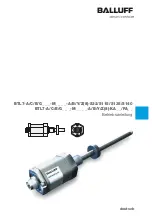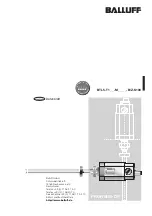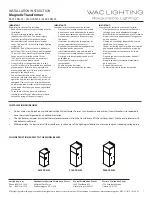
Page 2
WIRING
The particulate matter sensor has standard screw block connectors and easy wire access to facilitate wiring.
It is recommended that shielded twisted pair wiring at least 22 AWG be used for all connections and that
the device wires not be run in the same conduit with wiring used to supply inductive loads such as motors.
Disconnect the power supply before making any connections to prevent electrical shock or equipment
damage. Make all connections in accordance with national and local electrical codes.
The device power (24 Vac/dc) is connected to the terminal marked PWR (POWER). This terminal is used for
the positive dc voltage or the hot side of the ac voltage. The device is reverse voltage protected and as
such will not operate if connected backwards.
The common of the power supply is connected to the terminal marked COM (COMMON). Note that this
device has a half-wave type power supply which means the power supply common is the same as the output
signal common. Therefore, several devices may be connected to
one power supply and the output signals all share the same signal
common. Use caution when grounding the secondary of an ac
transformer or when wiring multiple devices to ensure that the
circuit ground point is the same on all devices and the controller.
In general, the transformer should not be connected to earth
ground when using devices with an RS-485 network connection.
The analog output signal is available on the OUT (OUTPUT)
terminal. This signal is jumper selectable for either voltage or
4-20 mA output signal type. See Figure 5. The voltage output
signal defaults to 0-5 Vdc but may be changed to 0-10 Vdc via
the menu. These options are clearly indicated on the device
PCB. The analog output signal is typically connected directly to
the Building Automation System (B.A.S.) and used as a control
parameter or for logging purposes. Check the controller Analog
Input type to determine the correct connection and signal type
before applying power. The device generates the analog output
signal (sourcing) and must not be connected to a powered input
or device damage may occur.
For voltage type output signal the device has a minimum load
that it is able to drive, similarly for current type output signal the
device has a maximum load that it is able to drive with a particular
power supply voltage. Observe and follow these ratings in the
Specification section or inaccurate reading may result. The 4-20
mA output signal can easily be converted to a 1-5 Vdc signal
for controllers accepting this type of input. Simply insert a 250
ohm (0.1% is best) resistor between the “+” and “-” inputs of the
controller. This will convert the 4-20 mA signal to the desired 1-5
Vdc. See Figure 6.
using the appropriate holes, remove the PCB from the anti-static bag and feed the wires through the
center hole of the PCB. Place the top of the PCB into the latches on the top of the backplate and gently
snap the bottom edge of the PCB into place as shown in Figure 4.
Make wire connections as per the Wiring Illustrations on Page 2 and install decorative cover by placing the
top of the cover into the cover holder on the top of the backplate and snapping the bottom into place as
shown in Figure 4. Tighten security screw with a screwdriver.
+ 24 Vdc/24 Vac (HOT)
COMMON
Analog Input
PWR
COM
OUT
Controller
Figure 4
Figure 6
Figure 5
Cover
PCB
Backplate
4-20 mA
4-20 mA
VOLT
VOLT
IN-GE-PMRMCXXX-05
Copyright © Greystone Energy Systems, Inc. All Rights Reserved Phone: +1 506 853 3057 Web: www.greystoneenergy.com


























